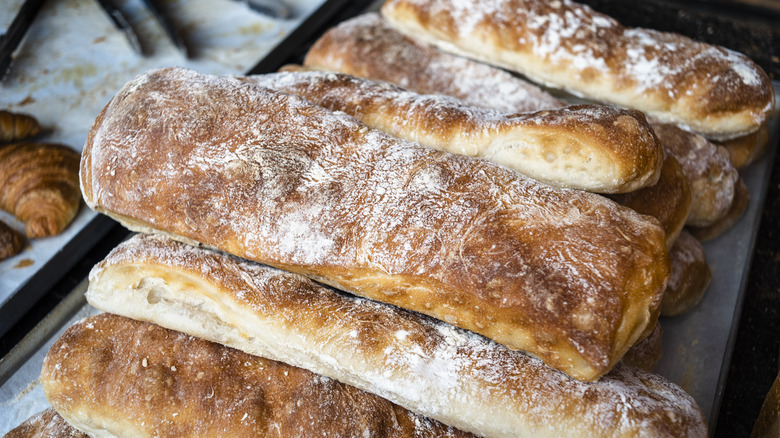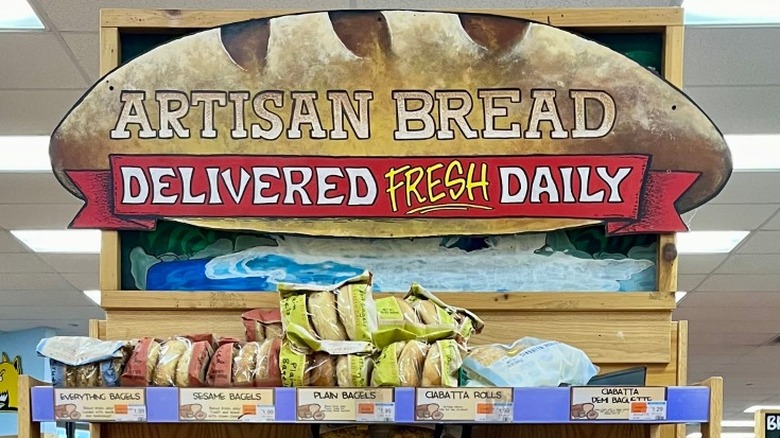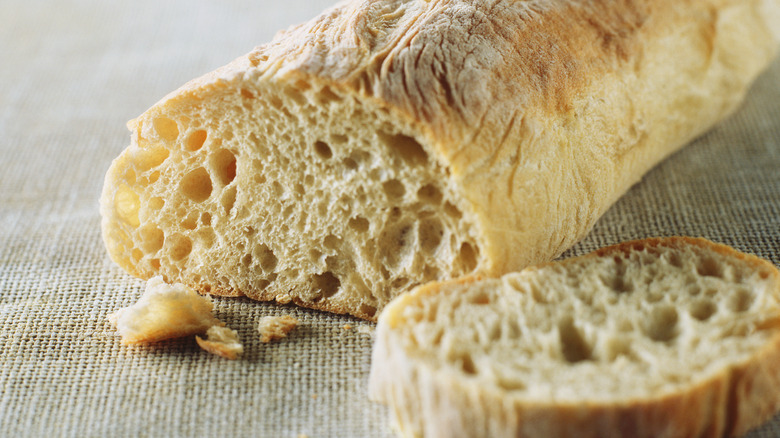The Spiteful Reason Ciabatta Bread Was Invented
Cleveland, Ohio. 1987. A new kind of bread makes its way to America for the first time. It's similar to a French baguette, but it's a little shorter, a little rounder, a little plumper. Its name means "slipper" in Italy, where it's a traditional bread, they say. Very quickly, it catches on. Soon it's in every Italian restaurant and deli in the U.S. It's so rustic, it oozes authenticity. It must have been a staple in Italy for hundreds of years ... but it wasn't.
By the time ciabatta bread reached the shores of America, it was barely five years old. It was invented in 1982, not too far from Venice, by a miller named Arnaldo Cavallari. He and his colleagues had, in a typically Italian turn of events, become appalled by the popularity of French bread throughout the country. Italians love sandwiches, you see. From panini stuffed with soppressata and mozzarella to the Florentine schiacciata, the market for Italian sandwiches is enormous. As brilliant as a baguette sandwich for lunch is, surely the French shouldn't be dipping their garlicky little fingers into Italian pockets, or so Cavallari thought. Surely the bread used for all those sandwiches had to be Italian. Something had to be done. So he did it.
After exhaustive testing (and supposedly a little serendipity) Cavallari presented his creation: a fairly flat, chubby loaf, with an incredibly crisp crust and an airy, open crumb. He named it for the slipper it resembled: ciabatta.
Ciabatta's global takeover was swift
Ciabatta was quick to catch on in Italy, but even more profoundly, abroad. By the mid-'90s, Arnaldo Cavallari had licensed production to 11 countries. In the U.K. and U.S., where consumers were hungry for a relatively overpriced taste of Italy, sales would skyrocket, with ciabatta fast becoming a staple of the upper-middle class shopping basket: the soccer mom's new favorite bread.
Some were quick to decry Cavallari's creation as old news, claiming that he'd simply repackaged a traditional recipe in an attempt to capitalize on a hole in the market. In an interview with The Guardian, he responded in bombastic fashion: "People can say whatever they like. Someone could say they remember eating it in the 1940s, but they have got to come forward with the proof. There is no question of that recipe having existed before." Regardless, the bread became a hit. Cavallari had accomplished his mission.
So what separates ciabatta from French bread?
There are, as it turns out, some marked differences between traditional French and Italian breads. Where French breads are known for their crusty exteriors and open crumbs, Italian breads, such as focaccia, are known for the opposite. They have dense, soft interiors great for mopping up sauces or oils. Ciabatta breaks that mold. With that super crackly crust (uncharacteristic of traditional Italian bread) and super high hydration making for a chewy yet light interior, it's closer to traditional French bread than Italian.
The ciabatta has a much higher hydration than the baguette, though, making for an airier interior and a more delicate flavor. It's a fantastic sandwich bread, which is unsurprising, really — that's the whole point of it. But it's good for more than just sandwiches; as you discover in many mid-market Italian restaurants, it might also be just about the best kind of bread to dunk luxuriously in olive oil.
Ciabatta is charming. Though it came about in just about the least organic way possible, spitefully created as a product to capture a market and oust a competitor rather than developed over generations, somehow it feels almost plucky. Maybe that's because it has always been framed as an underdog: a slightly misshapen accident that stood up to the might of French breadmaking and won.



